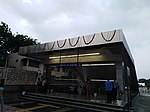Bhikaji Cama Place metro station
Delhi Metro stationsDelhi Metro stubsDelhi railway station stubsRailway stations in South Delhi districtUse Indian English from September 2016

The Bhikaji Cama Place metro station is located on the Pink Line of the Delhi Metro. The station was opened on 6 August 2018. Bhikaji Cama Place Metro Station is situated on the Ring Road. It is named after Bhikaji Cama the Indian freedom fighter, who is credited with creating an early version of the Flag of India based on the Calcutta Flag
Excerpt from the Wikipedia article Bhikaji Cama Place metro station (License: CC BY-SA 3.0, Authors, Images).Bhikaji Cama Place metro station
Delhi Metro Pink Line (underground), New Delhi Netaji Nagar (Vasant Vihar Tehsil)
Geographical coordinates (GPS) Address Nearby Places Show on map
Geographical coordinates (GPS)
| Latitude | Longitude |
|---|---|
| N 28.570211194444 ° | E 77.187888194444 ° |
Address
Bhikaji Cama Place
Delhi Metro Pink Line (underground)
110023 New Delhi, Netaji Nagar (Vasant Vihar Tehsil)
Delhi, India
Open on Google Maps




